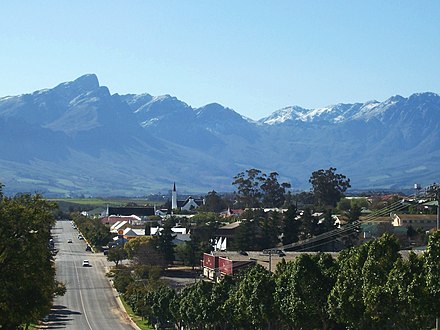Tulbagh - place in Western Cape, South Africa
Tulbagh is a charming historical town in Cape Winelands. There are lots of things to do and see, places to eat, scenic hiking trails, sport, horse riding, camping and other places to stay for self-catering or bed and breakfast.
Understand
 Tulbagh is in the Witzenberg Municipal Area, near Wolseley, Prince Alfred's Hamlet, Gouda and Ceres, in the Winelands of Boland in the Western Cape Province.
Tulbagh is in the Witzenberg Municipal Area, near Wolseley, Prince Alfred's Hamlet, Gouda and Ceres, in the Winelands of Boland in the Western Cape Province.
Europeans arrived in 1658, and it was settled in 1700 when land grants were made to 14 farming families. The town was developed in 1743 when the church was built. After the earthquake in 1969 every home in Church Street was restored. These 32 buildings were all declared National Monuments and constitute the largest concentration of National Monuments in one street in South Africa.
The town is on the northern end of the beautiful and fertile Tulbagh valley. The valley is almost completely surrounded by majestic mountain ranges - the Obiqua mountains to the west, the towering Winterhoek on the northern end and the Witzenberg on the eastern side of the valley. The Great Winterhoek mountains tower 2077 m above sea level and are picturesquely snowcapped in winter.

Towns such as Wellington, Malmesbury, Paarl, Franshoek, Riebeek Kasteel, Malmesbury, Piketberg, Porterville, Stellenbosch, Worcester and Rawsonville are within three quarters of an hour's drive from the valley and Cape Town is 120 km away.
Get in
Get around
See
Do
Tulbagh hosts various events every year:
- In June, the village Christmas in Winter.
- In September the Tulbagh Spring Arts Festival showcases a variety of visual and performing arts.
- Also in September, the annual Tulbagh Horse & Wildflower Show.
The Tulbagh Wine Route: wine has been produced for many years in the basin on a commercial scale. There are many wine estates in and around the town.
Buy
Eat
Drink
Sleep
- Themika Guest Farm, Tulbagh Road, +27 78 567-2441, stay@themika.com. Stay at Themika guest farm and enjoy a weekend of relaxing, ideal for wedding groups and families. Average R220 ppn
Connect
Go next
Tulbagh
Cape Winelands District Municipality
2nd-order administrative division
Western Cape
Primary administrative division